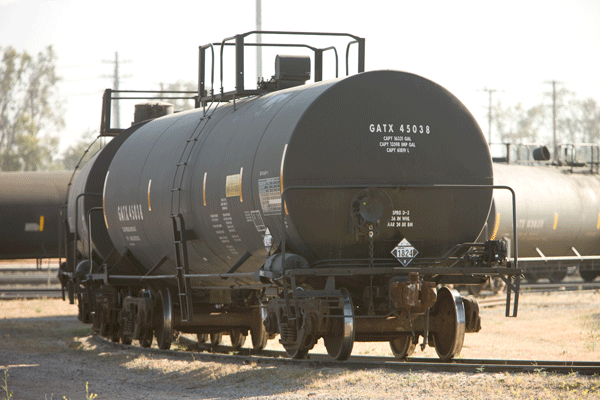The assignment for NACE International’s Specific Technology Group (STG) 43, “Transportation, Land,” is to promote the development of techniques to extend the life of land transportation equipment. The committee primarily focuses on writing standards and reports on industry best practices for coating application and corrosion control in and on railcars that target owners, operators, and repairers of railroad tank and hopper cars. STG 43 also hosts technical information exchanges (TIEs) through meetings of its technology exchange groups (TEGs).
The railcar industry, like many other regulated industries, has found a need for standards that foster best practices within the industry. “One objective of STG 43 is to help provide consistency in the industry’s selection and application of coating systems to railcars,” says NACE member Maria Betti, senior chemical engineer with GATX Corp. (Chicago, Illinois) and chair and vice chair of several task groups (TGs) currently writing industry standards and state-of-the-art reports. With the North American rail fleet expanding to accommodate the continuing demand from the oil and gas sector, NACE standards can indeed contribute to that consistency in the selection, application, and inspection of coatings systems for railcars.
Meeting the Needs of a Growing Industry
According to Rail Time Indicators,1 “Crude oil and natural gas output is growing largely due to the expansion of fracking and horizontal drilling, and much of the increase in rail rolling stock is associated with tank cars (for carrying crude oil) and covered hoppers (for, among other things, frac sand).”
The fourth quarter 2015 Umler® Equipment Index reports that the number of freight cars in the North American rail equipment revenue-earning fleet is ~1.61 million cars.2 Of six sub-fleets within the revenue-earning fleet, the two largest are tank cars (422,977) and covered hopper cars (545,856), which represent ~60% of the total revenue-earning fleet,1 and are the primary focus of NACE land transportation standards produced by the STG 43 task groups.

“The NACE standards [such as NACE SP03983] are used to develop training for railcar coating applicators and inspectors, and they are also included in coating manufacturer application specifications as guidelines for railcar shops,” says NACE member Tim Schaeffer, chair of STG 43 and vice president, Coating Operations, with GBW Railcar Services, LLC (Conway, South Carolina).
Some of STG 43’s standards are written to satisfy regulatory requirements, such as the standard that TG 444 is writing to provide guidelines for inspecting, rating, and documenting the condition of interior coatings and linings in railroad tank cars to comply with U.S. Code of Federal Regulations (CFR) Title 49, Part 180.4
“Our ability to do our jobs and continue our businesses hinges on the training programs and work procedures we develop using NACE standards, and demonstrating to the Federal Railroad Administration [FRA] and U.S. Department of Transportation [DOT] that such standards are in place and that we are following them,” says NACE member Jim Molnar, manager, Coatings R&D, UTLX (Chicago, Illinois), and past STG 43 chair and current chair of several task groups. “We have a vested interest in reducing chaos and introducing some level of uniformity in our industry for both commercial and regulatory reasons,” he continues.
Changes in Railcar Regulations
While recent regulatory changes affecting the railroad industry were passed in 2015 by the DOT’s Pipeline and Hazardous Materials Safety Administration (PHMSA) and the FRA,5 STG 43 members Betti, Schaffer, and Molnar do not think the new regulations will have a major or immediate effect on the published NACE standards or those currently in development. This is because the NACE standards focus on the selection and application of coating systems for railcars, and the new regulations update the design requirements for manufacturers of railcars used for transporting flammable liquids. Still, a new task group, TG 535, has been established to study and report on potential corrosion issues (one of these is flammables) when transporting crude oil, and methods for ongoing mitigation.
Call for Members
STG 43 has a very active membership, but there is always room for more members who wish to participate in the TGs and TEGs. STG 43 and the current committees meet during CORROSION in the spring and also in the fall during Corrosion Technology Week. If you are interested in finding out more about how you can participate in the TGs and the TEGs, log into your profile on the NACE Web site and join STG 43. You will then be advised when a consensus body (ballot pool) is being developed for a STG 43 standard or report.
Contact Trudy Schreiner, NACE International standards editor—e-mail: trudy.schreiner@nace.org.
References
1 “A Review of Key Economic Trends, Shaping Demand for Rail Transportation Policy & Economics Department,” Rail Time Indicators June (2014).
2 “Railinc Rail Industry Indexes – Fourth Quarter 2015,” https://www.railinc.com/rportal/railinc-indexes/-/blogs/umler-equipment-index-fourth-quarter-2015?p_p_auth=0YfxCAIu (March 3, 2016).
3 NACE SP0398 (formerly RP0398), “Recommendations for Training and Qualifying Personnel as Coating Inspectors in the Railcar Industry” (Houston, TX: NACE International).
4. U.S. Code of Federal Regulations (CFR) Title 49, Chapter I, Subchapter C—Hazardous Materials Regulations, Part 180, “Continuing Qualification and Maintenance of Packagings” (Washington, DC: Office of the Federal Register, 2011).
5 “Hazardous Materials: Enhanced Tank Car Standards and Operational Controls for High-Hazard Flammable Trains,” Federal Register Rules and Regulations 80, 222 (2015): p. 71952.